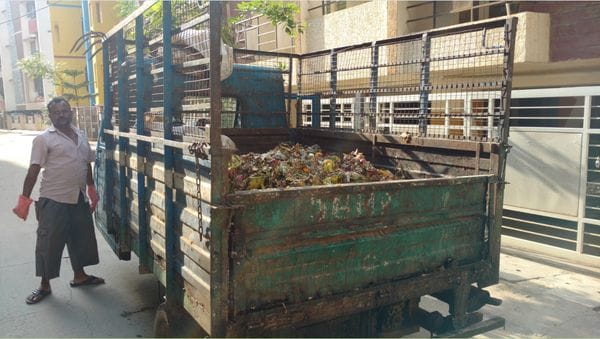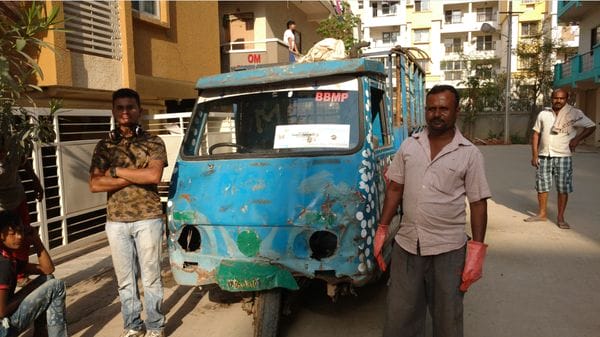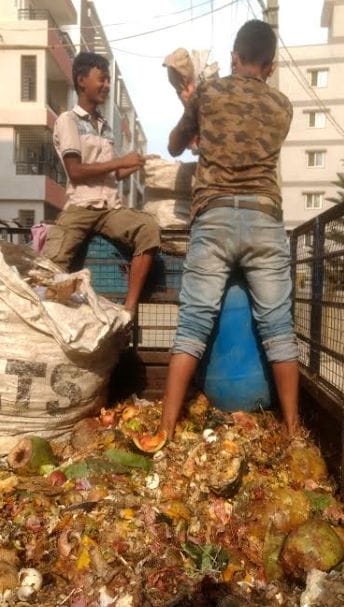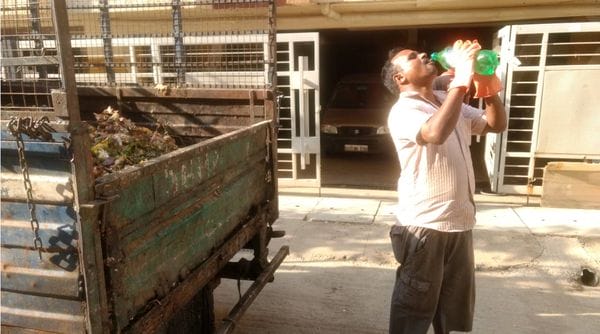Every day we produce tonnes of organic waste – banana peels, potato skins, egg shells, and wasted food – that all get dumped into the dustbin. Most of us give no second thought to where this garbage is going, let alone the people who come to whisk it out of our lives.

Pic: Sanaya Katrak
A candid chat with the group of garbage collectors doing their rounds in Green Glen Layout, Bellandur every morning, offered a peek into their daily encounters. They were immensely grateful for even the chilled bottle of water given to them as they willingly talked of their day-to-day battles.
The men and boys reside at Kaikondrahalli, where they wake each morning at half past five and make their way to the mustering point near Total Mall, where they are required to assemble before they start their rounds. Their attendance is recorded through a group photograph, after which they begin their familiar route, with nothing but a cup of chai to keep them going.

Pic: Sanaya Katrak
“Who will give us breakfast so early in the morning?” is 35-year-old Jaffer’s response to how they cope with their empty stomachs until the afternoon. The group goes from apartment to apartment in the community, collecting their sorted green waste and reject waste. As instructed, they do not collect waste that has been mixed together, telling uncooperative apartments to ensure they follow the segregation rules if they wish to have their garbage collected.
As anyone can guess, this is not a pleasant job to do, but the lack of amenities provided to them exponentially increases its difficulty and how unhygienic it is. No gloves or appropriate shoes have been provided to the group, and they were left with no option but to sort through the stinking mass of garbage barehanded, and climb into it with just a ragged pair of canvas shoes.

Pic: Sanaya Katrak
After sufficient requests, a single pair of rubber gloves and a health mask has been given to them. Repeated promises that they will be given rubber boots are all that they get, leaving them resigned to their conditions. Jaffer’s 17-year-old son has learnt to live with this, saying, “If they do not provide us with the shoes, how else can we get them?”
Jaffer has two children, a 15-year-old daughter who attends school, and his son who accompanies him on the job. It appears that he tried hard to get his son to complete his education, but his son has no interest in studying further. He has now been following the footsteps of his father for the past two years. Jaffer himself has been working in the profession for around five years.
 15-year-old Taizur, who has an injured eye. Pic: Sanaya Katrak
15-year-old Taizur, who has an injured eye. Pic: Sanaya Katrak
Another member of the group is 15-year-old Taizur, who lost his left eye when he was aged two, living in Delhi, in an accident on Diwali involving firecrackers. Taizur has not been working for longer than a month or so. He explained that as the work is new and unfamiliar to him, it is not good as he often does not know what to do. Another young boy was also with them, and the three agreed how rare it was that anyone stopped to ask them about their lives, as they feel not much thought or importance is given to the work they do.
Once the garbage pickers dump their day’s collections in the ‘bada gaadi’ on Sarjapur Road, it is no longer their responsibility and they do not know where it goes next. They are done with all their work for the day, and return to their homes with nothing else to do. Their meagre income used to come from selling the dry, recyclable waste, but now that it is no longer their duty to collect it. They have been promised a collective salary of ₹10,000 a month, but are yet to receive it.

Pic: Sanaya Katrak
The stench of rotting vegetables is one which most people would avoid like the plague, but these workers have no choice but to breathe it in day after day. “At the beginning, when you are new to the job,” said Jaffer, “you tend to get more affected by the smell. But what to do about it, you just have to try and ignore it.” After his years surrounded by the disgusting odour, however, it hardly bothers him anymore. The discomfort does not end there, as the job requires standing for hours on end with hardly any chance for a rest.
The truth of such an occupation is that no one wishes to immerse themselves in the filth, but the job has to be done by someone. Despite the almost inhuman conditions and the lack of dignity associated with such work, the need for an income to support his family, and the accessibility of the job drives Jaffer and his group to continue working sincerely and with a dedication that is hard to find.
Related Articles
A Day in the City
A day in the life of a BMTC conductor
Five reasons why your cab driver does not land up on time
How have things changed for cab drivers in Bengaluru?
Nice writeup. While I sympathize with the poor working conditions of these workers, I have to admit, this is a classic case of a job shoddily done with 0 political will or intent.
The task of “transferring” garbage from small, noise-polluting 3-wheeled garbage vehicles to larger lorries that we routinely see in Bangalore, is an example of littering more than cleaning! I have seen the place near Kaikondrahalli Lake where this happens. They literally dirty and mess up a rectangular area of nearly 500 square meters (10m x 50m). The place becomes a mess and continues to stink long after the “transfer” has happened. It then gets automatically earmarked as a permanent place for doing this “transfer”. I pity the residents living nearby. This “transfer” seems to be a phenomenon unique to Blore. And I have seen this “transferring” activity in several places in Blore, such as on Wind Tunnel Road about 0.5 km before Old Airport Rd. Then again on St Johns Cross Rd leading to Tavarekere Main Rd. I have lived several decades in Mumbai and Pune, and I have never seen this “transferring” activity there!
The proper way to collect garbage (and I have seen this in Mumbai, Pune and Chennai) is for garbage workers to use hand-drawn wheelie bins for narrow gullies. I have seen this in India being done by uniformed municipal workers. If the gullies are navigable by a 3-wheeler, then a 3-wheeler will go and pick garbage. Then there will be small hubs where the wheelie bins will dump their lot into the 3-wheelers. Being small qty, there is less chance of spillage (see http://www.umcasia.org/images/swm2.jpg). Lastly, the 3-wheeled rickshaws or Tata Ace mini dump trucks will dump their loads into a mechanize-amenable larger container (see https://ak6.picdn.net/shutterstock/videos/9461768/thumb/3.jpg or http://www.nswaienvis.nic.in/National_News2016/National_news_Feb16/img/CHENNAI_10February2016.png). These are then serviced by fully-covered garbage trucks with Airtech Schorling compactors and mechanized arms, along with some support staff to clean the surroundings in case some garbage spills when auto-loading.
Lastly, in Mumbai, in case any garbage trucks travel with non-closed containers, then they always travel with a very large cloth trapping laid over the garbage so that the loaded garbage doesnt fall back on the streets due to wind when driving. These garbage trucks are owned by the municipal corporation, not contracted out. Mumbai’s BMC has a very large fleet (probably one-fifth the size of BMTC fleet) of fairly well maintained custom-designed compactor garbage trucks for this (see http://www.freepressjournal.in/wp-content/uploads/2016/12/05-01.jpg), that can travel fast at highways speeds to the landfill or segregation site as the case may be. I have never seen slow-moving garbage tractors in use in Mumbai/Pune, as I routinely see in Bangalore, which end up being a eye-sore as well as traffic disrupter.
All in all, a well thought out scheme with plenty of equipment and workforce is needed. Not like the sham in Blore, where its looked at as an opportunity by BBMP to siphon away funds.